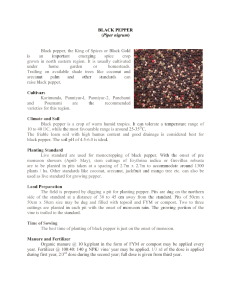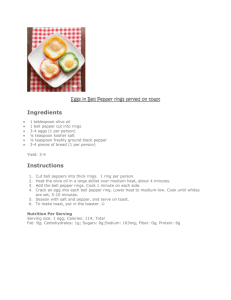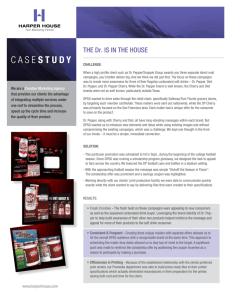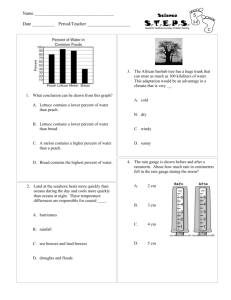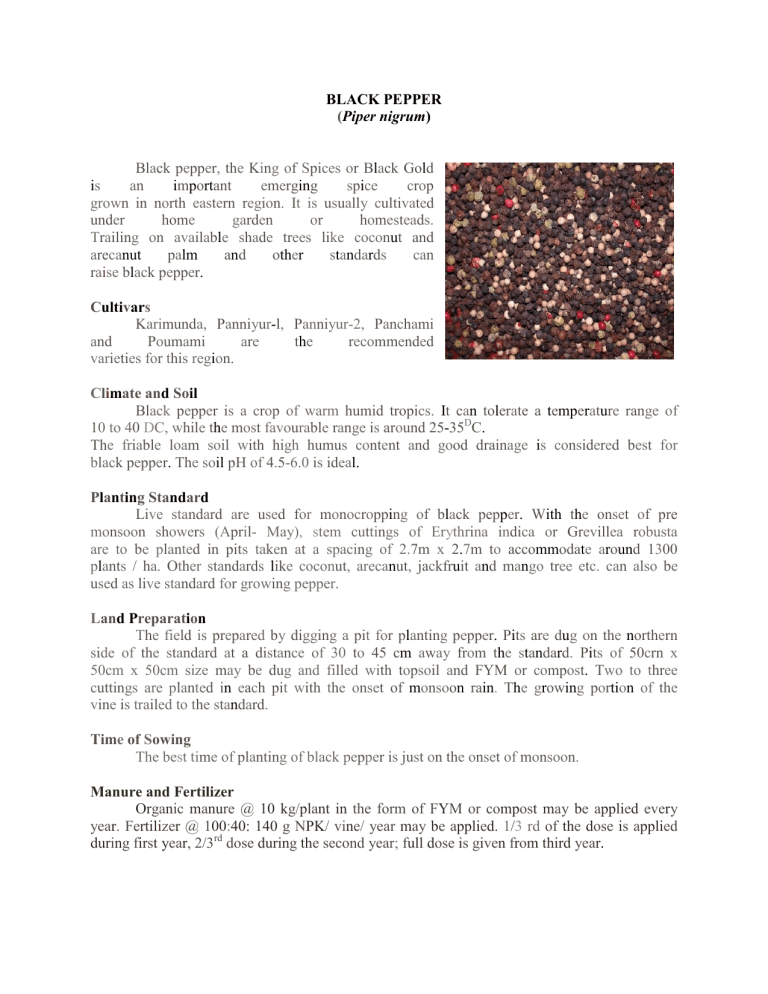
BLACK PEPPER (Piper nigrum) Black pepper, the King of Spices or Black Gold is an important emerging spice crop grown in north eastern region. It is usually cultivated under home garden or homesteads. Trailing on available shade trees like coconut and arecanut palm and other standards can raise black pepper. Cultivars Karimunda, Panniyur-l, Panniyur-2, Panchami and Poumami are the recommended varieties for this region. Climate and Soil Black pepper is a crop of warm humid tropics. It can tolerate a temperature range of 10 to 40 DC, while the most favourable range is around 25-35DC. The friable loam soil with high humus content and good drainage is considered best for black pepper. The soil pH of 4.5-6.0 is ideal. Planting Standard Live standard are used for monocropping of black pepper. With the onset of pre monsoon showers (April- May), stem cuttings of Erythrina indica or Grevillea robusta are to be planted in pits taken at a spacing of 2.7m x 2.7m to accommodate around 1300 plants / ha. Other standards like coconut, arecanut, jackfruit and mango tree etc. can also be used as live standard for growing pepper. Land Preparation The field is prepared by digging a pit for planting pepper. Pits are dug on the northern side of the standard at a distance of 30 to 45 cm away from the standard. Pits of 50crn x 50cm x 50cm size may be dug and filled with topsoil and FYM or compost. Two to three cuttings are planted in each pit with the onset of monsoon rain. The growing portion of the vine is trailed to the standard. Time of Sowing The best time of planting of black pepper is just on the onset of monsoon. Manure and Fertilizer Organic manure @ 10 kg/plant in the form of FYM or compost may be applied every year. Fertilizer @ 100:40: 140 g NPK/ vine/ year may be applied. 1/3 rd of the dose is applied during first year, 2/3rd dose during the second year; full dose is given from third year. Training and pruning As the black pepper cuttings grow, the shoots are to be tied to the standards as and when required. When pepper is trailed on coconut palm or arecanut palm it is necessary to restrict their upward growth so as to avoid inconvenience to the climber for harvesting and spraying. For this purpose, when the vertical growth attains 5-6 meters, the terminal shoots are to be either pruned or lifted and bend down carefully to avoid breaking. Irrigation Irrigating pepper plants from November-December till the end of March and withholding irrigation till monsoon break increases pepper yield by about 50 %. Plant Protection Top Shoot borer (Cydia hemidoxa meas)- Fully grown larvae, which are grayish green, bore into tender terminal shoot and feed on tissues and retard growth of young vines. Spraying of Monocrotophos (0.05%) during July and September is found to control this pest. Leaf gall thrips (Liothrips karnyl)-Adult and larvae feeds on tender leaves inducing formation of marginal tubular galls on leaves. Leaves become crinkled and reduced in size. Spraying 0.05 % Monocrotophos or Dimethoate on tender leaves is recommended. Foot rot (Phytophthora capsicii- Black spot on leaves are formed which enlarge rapidly and cause fall of the leaf. When the main stem at the base is damaged, the entire vine wilts and shed all the leaves and spikes. Remove and destroy all infected plants and provide good drainage to prevent water stagnation during rainy period. Foliar spray of Bordeaux mixture (1 %) can control the disease. Anthracnose (Pollu disease) (Colletotrichum gleosporioides) - Dark brown irregular spots having a yellow halo appear on the leaf tip or lamina and also on the berries. The disease infects the berries and they show sunken patches during early stages. Discolouration gradually spreads and develops characteristic cracks on them. Spray Bordeaux mixture I % during May-June and September-October will control the disease. Harvesting and Yield Pepper vines start yielding usually from 3'd or 4'h after planting. Vines flower in MayJune and it takes 6-8 months from flowering to ripening stage. Harvesting is done from end of November to early February. When one or two berries in a spike turn bright orange to red, the whole spike can be harvested. A well managed and full bearing vine may yield on an average 2 to 2.5 kg of pepper.

